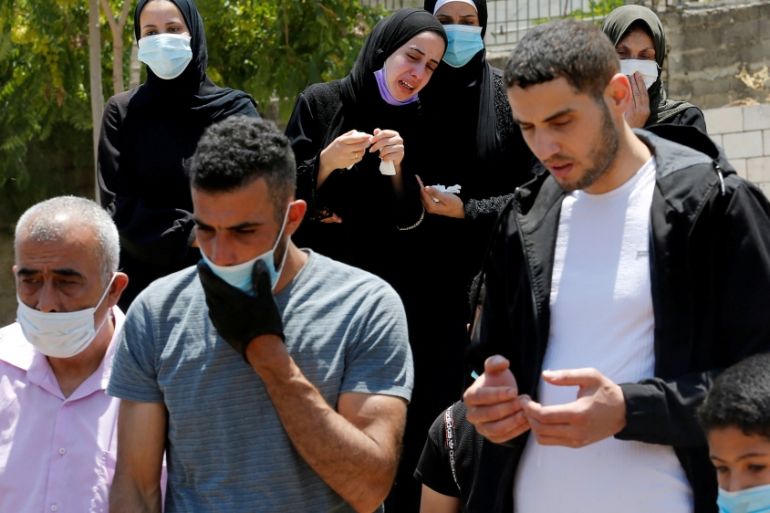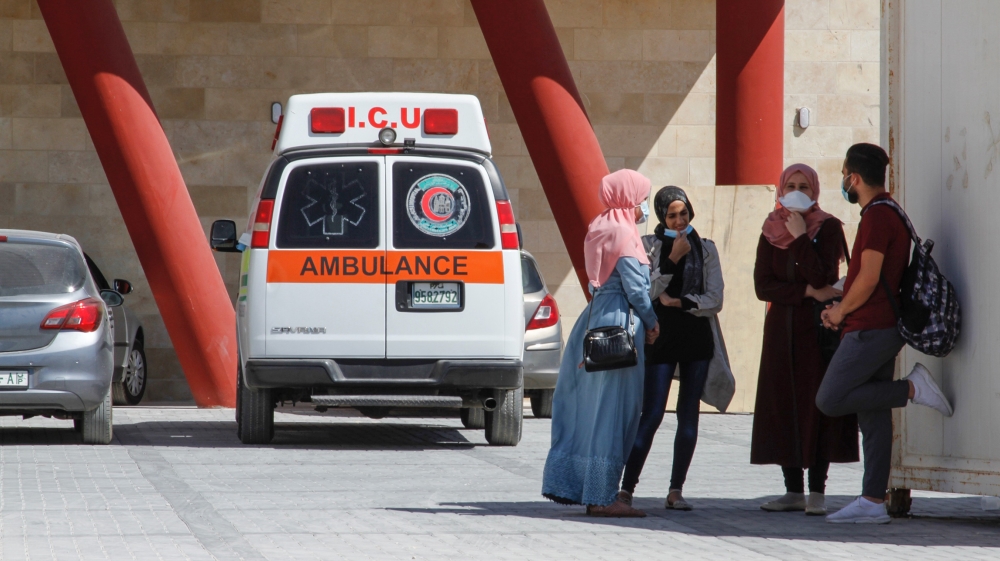Coronavirus cases surge in occupied West Bank
Officials warn ‘community transmission’ fuelling outbreak as coronavirus cases continue to rise.

Hebron, Occupied West Bank – The number of COVID-19 cases in the occupied West Bank, East Jerusalem and Gaza reached 13,457 on Friday, according to the ministry of health, after a surge in infections in the second half of July.
According to the MRC Centre for Global Infectious Disease Analysis at Imperial College London, the rate at which the disease is transmitted in the occupied West Bank has reached 1.58, meaning that every two infected individuals are likely to spread the virus to three more.
Keep reading
list of 4 items‘We’re on the edge’: Palestinians terrified by Israeli settler violence
Palestinian man killed in Israeli settler raids in occupied West Bank
Israeli forces assault Palestinian boy over ‘gun’ shirt
The Palestinian Authority (PA), which exercises limited control over some areas of the occupied West Bank, has struggled to contain the spread of the virus.
When the PA eased a lockdown following street protests in late May, there were less than 130 confirmed coronavirus infections. It has since reimposed a partial lockdown in response to the increase in reported cases.
However, spotty adherence to social distancing guidelines remained widespread across the West Bank, while a lack of control over borders and the movement of people have elevated the problems faced by the Ramallah-based administration.

New epicentre
Of the 8,796 active cases, more than half of have been reported in Hebron governorate in the southern West Bank.
On a recent weekend in Hebron city, with a population of more than 750,000, the local authorities appeared ineffective or unwilling to enforce a routine lockdown. Vehicle traffic in and out of the city flowed unhindered, and many businesses were open.
“I decided to open my shop when I saw that by noon everybody was open,” Ahmad al-Qaisi, an upholstery retailer from Hebron told Al Jazeera.
In late June, as it became clear that Hebron was the epicentre of the outbreak, the health ministry directed more staff and supplies to the area. A new hospital in Dura, near Hebron city, was repurposed upon opening to exclusively treat COVID-19 patients.
“From the start, they brought the hardest cases here that need intensive care,” Dr Muhammad Ribie, the administrator of the hospital, told Al Jazeera. “Of course, it was a big challenge for us,” he said.
The hospital at Dura was first supplied with six ventilators, 10 intensive care unit beds, and 100 beds for minor cases, Ribie said. After a visit by the Palestinian health minister, Dr Mai Keleh, six more ventilators were sent along with 10 more ICU beds as cases in the region surged.
The Dura hospital was also equipped with an oxygen generator, but Ribie said an additional generator is still needed to meet the demand.
“The treatment of the majority of the corona patients is by oxygen,” Ribie said. “If the generator cannot produce enough, we switch to oxygen tubes and those run out fast and then we have to send them to Hebron to be refilled. This is not practical,” he added.
In early July, as the number of cases in the Hebron region was surging, the demand for test kits resulted in a shortage that led authorities to temporarily use serological testing instead. The health ministry replenished test kit supplies the next day, but public anger mounted.

‘Community transmission’
A local health official who is privy to the COVID-19 situation in the West Bank told Al Jazeera on condition of anonymity that the number of daily detected cases is worrying. During the last two weeks of July, newly detected cases averaged around 500 a day.
“This is a high figure when we think about the low number of tests performed,” he said. “We’ve been performing around 35,000 tests for every one million people, and this is not enough.”
“Israel ran far more tests … The UAE ran 490,000 for every one million people,” he said. “We are short of money.”
At the beginning of the health crisis, the PA struggled to limit the spread of the disease in the West Bank via workers who travel to and from Israel. There are 10 official crossings between the West Bank and Israel, and 300 more unofficial crossings, Mai Keleh said in a recent TV interview.
The PA does not have the resources to control labour traffic for all those points of entries. Also, many of the unofficial crossings are located in Area C of the West Bank where the PA has no control.
However, the situation has far worsened now. The majority of the recent transmissions in the West Bank are “community transmissions,” the Palestinian health minister said recently.
The health official told Al Jazeera that these account for “more than 61 percent of the cases”.
Economic impact
The economic fallout from coronavirus has been severe, with the ministry of economy estimating losses from the standstill at more than three billion dollars.
Palestinian Prime Minister Muhammad Shtayeh this week announced agreements with the Palestinian Monetary Authority on several measures to ease the economic strain.
Banks were ordered not to slap fees on returned checks. In addition, they were also instructed to not deduct loan payments owed by their clients when the PA transfers salaries to its employees.
According to data from the Palestinian Monetary Authority, the value of returned checks in the West Bank has soared in recent months to $389m.
Ahmad Quaisi, the young upholstery merchant from Hebron, believed the policy has a downside because it has encouraged some to abuse it.
But for now, he said, “We’ve transitioned from accepting checks to cash; we sell on a cash basis, only.”
Before the pandemic, he imported as many as 10 containers a month of merchandise from China, Turkey and Europe. That has changed, he said, as fewer customers are buying from his shop.
“Importing has been scaled back. The purchasing power is gone. Now, I import two containers a month.”